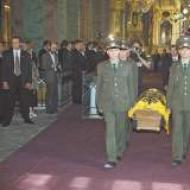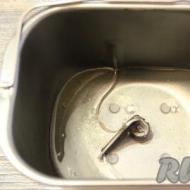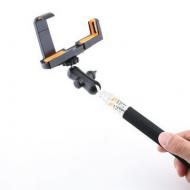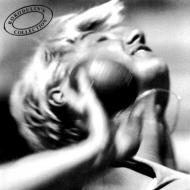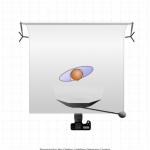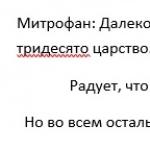
Typical types of damage to cars that occur during an accident. VAZ cars, repair after accidents, car restoration, replacement of units and repair of parts. Seats with headrests
Page 6 of 10
4. Methodological provisions for establishing the availability
and the nature of technical damage to vehicles
4.1. The presence and nature of technical damage to vehicles is determined by the type of impact that caused them, which are divided into mechanical, thermal and chemical.
4.1.1. Mechanical effects are due to the mechanical interaction of the object of examination with other vehicles or objects, as well as explosions. The main types of damage caused by mechanical impact include scratches, chipping, dents, scuffing, extrusion, chipping, separation, breakage, shearing, knocking out, falling out, peeling, tearing, puncture, breakdown, fold, crack, change in the location of structural elements relative to each other. other (skew, displacement, jamming, jamming, sinking, beating, stretching, twisting, bending), complete destruction.
4.1.2. Thermal effects are caused by the action of high temperatures on the object of examination due to a fire or explosion. The main types of damage caused by thermal exposure include swelling, burning, melting, soot, warping.
4.1.3. Chemical impacts are caused by reactions occurring under the influence of chemically hazardous substances (cargoes) on the object of examination or during explosions. The main types of damage caused by chemical exposure include corrosion, swelling, melting, flaking, soot, and warping.
4.2. In terms of performance impact vehicle technical damages are divided into failures and malfunctions. A failure is a loss of vehicle operability due to an unacceptable change in its parameters or properties. The malfunction characterizes the state of the vehicle, in which at least one of its main or additional options does not meet the requirements of technical documentation, as a rule, without loss of vehicle performance.
4.3. According to the degree of manifestation and the possibility of detection, technical damage is divided into detectable by organoleptic methods and hidden. To identify hidden damage, methods are used to study the technical condition of the vehicle using technical diagnostic tools.
4.4. Damage as a source of information about a traffic accident can be divided into 3 groups.
The first group - damages formed during the mutual introduction of two or more vehicles at the initial moment of interaction. These are contact deformations, a change in the original shape of individual parts of vehicles. Deformations usually occupy a significant area and are noticeable during external examination without the use of technical means. The most common case of deformation is a dent. Dents are formed in the places where forces are applied and, as a rule, are directed inside the part (element).
The second group is breaks, cuts, breakdowns, scratches. They are characterized by a through destruction of the surface and the concentration of the trace-forming force on a small area.
The third group of damages are imprints, i.e. surface displays on the trace-perceiving area of the surface of one vehicle of protruding parts of another vehicle. Imprints are peeling or layering of a substance that can be mutual: the peeling of paint or other substance from one object leads to a layering of the same substance on another.
Damages of the first and second groups are always volumetric, damages of the third group are superficial.
4.5. It is also customary to single out secondary deformations, which are characterized by the absence of signs of direct contact of parts and parts of vehicles and are the result of contact deformations. Parts change their shape under the influence of the moment of forces that occurs in the case of contact deformations according to the laws of mechanics and resistance of materials. Such deformations are located at a distance from the place of direct contact. Damage to the side member (spars) of a car can lead to a distortion of the entire body, i.e. the formation of secondary deformations, the appearance of which depends on the intensity, direction, place of application and magnitude of the effort in the process of a traffic accident. Secondary deformations are often mistaken for contact ones. To avoid this, when inspecting vehicles, first of all, traces of contact deformations should be identified and only after that secondary deformations can be correctly recognized and identified.
4.6. The most complex damage to a vehicle is distortion, characterized by a significant change in the geometric parameters of the body frame, cab, platform and sidecar, door openings, hood, trunk lid, windshield and rear window, spars, etc.
4.7. The main share of technical damage to the vehicle is damage to the elements of the body and plumage. The body and plumage of a passenger car include the following main elements: body frame, hood, trunk lid (tailgate), side doors, fenders, decorative details (radiator trim panel, front and rear bumpers, decorative overlays, etc.). The main elements of the body and plumage of a truck are: a frame, a cab, cab doors, a radiator lining panel, a hood, fenders, footboards, an onboard platform (base, sides, awning frame) or a bucket-type platform and a subframe for a dump truck. The main elements of the body and plumage of the bus are: body (base - frame, floor panels, floor casings, front - frame and panels, sidewall - frame and panels; rear - frame and panels, roof - frame and panels), front door, rear door , cab door, hood, front fenders, rear fenders, footrests.
Damage to the elements of the body and plumage is characterized by the area of damage, the location of the damage, their linear and volumetric dimensions (length, width, depth), shape, as well as their coordinates relative to the undamaged part of the vehicle.
According to the degree of deformation, damage to body elements and plumage made of sheet material is divided into three groups. The first group includes damage to the surface of the element that did not cause a change in the shape of this element (scratches, small dents), the second - damage that caused smooth deformation (without folds and creases) of the element, the third group - damage that caused complex deformation (folds, creases). ) element.
4.8. Damage to vehicle tires is divided into punctures, breakdowns, cuts, ruptures, "pneumatic explosions", tire disassembly, tire tread peeling.
4.9. When describing technical damage, it is advisable to use vehicle damage classifiers, in particular, the Unified classifier of malfunctions of automotive products.
As a rule, information about vehicle damage contained in the protocols for examining the scene of an accident and transport is not enough for their full and qualified assessment by experts. Therefore, the expert (specialist) usually receives the necessary information during a direct examination of the vehicle. In view of the diversity and multiplicity of the results obtained, it is advisable to present them in a systematic way.
Before inspection, the vehicle is placed in a position convenient for inspection, base lines are applied to the supporting surface (usually parallel to the intact axis of the vehicle wheels and the longitudinal axis at some distances from them).
Identify and classify traces on damaged vehicles.
Traces how sources of information about road accidents can be divided into three groups (see Figure 29).
/ Group - this is primary and secondary deformations. Primary deformations - contact deformations, consisting in a change in the initial shape of the vehicle or its individual parts, formed at the initial moment of interaction of the vehicle during a collision.
The most characteristic types of primary deformations are dents - depressions, the depth of which exceeds the initial width of the deformed surface (1, 12).
Secondary deformations are the result of primary contact deformations and are characterized by the absence of signs of direct contact between parts and parts of the car. Parts of the vehicle that have a small coefficient of elasticity are subject to such deformations, and they are localized, as a rule, within the same body part.
// group of traces - this is breaks(damages of irregular shape and with jagged edges), badass - small breaks in the metal or coating, the length of which is greater than its width, as well as cuts - a linear discontinuity formed when a hard, sharp surface slides over a softer one (a shallow incision without through penetration, usually formed by the protruding part of the vehicle, is called scratch). The II group of traces also includes breakdowns - Irregularly shaped damage, depending on the configuration of the trace-forming object and the direction of impact, which is usually perpendicular to the trace-receiving surface.
III group of traces - this is prints, i.e., surface displays on the trace-receiving surface of one vehicle of the contacting parts of another object, not associated with a violation of the integrity of its shape or surface. In an accident, fingerprints can form on one vehicle or on both. They represent peeling or flaking substances that can be mutual: peeling off a paint or other substance from one object leads to a layering of the same substance on another.
Traces that occur on the vehicles interacting in the process of an accident can be classified according to the mechanism of their formation, as indicated in Scheme 29.
Deformed parts of the vehicle, which they contacted during a collision, make it possible to roughly judge the relative position and mechanism of interaction of the vehicle.
imprints allow you to set the relative position of the vehicle at the time of the collision, the direction of impact.
Tracks on the vehicle(scratches, furrows, etc.) make it possible to establish the fact of the movement of the vehicle at the moment of impact, to determine the relative movement and nature of the movement of the vehicle.
Tracks on parts of the vehicle in contact with the road, make it possible to determine the direction of movement of the vehicle after a collision, to clarify the place of the collision.
Layering of TC microparticles are used to establish the fact of their contact interaction and identify colliding vehicles.
When two vehicles moving in the same direction in parallel, scratches can be used to determine which of them had a higher speed. To do this, the shape of the scratch is examined: if the narrow end of the scratch is directed towards the front of the car, then this car had a higher speed, and vice versa. With a horizontal, unchanging arrangement of scratches, it can be concluded that the speed of the car is constant at the time of the collision. If the scratches on the vehicle are pointing down or. up, this means that at the moment of contact one of them was subjected to sharp braking.
When examining the exfoliated primer in the scratch zone, it is often possible to find that it has the shape of a drop. The wide end of the melted track is directed towards the action of the forces that caused the delamination. Cracks located on the sides of the drop-like delamination of the primer, their ends are also directed towards the application of force. |
The nature of the damage to the vehicle may indicate the type of incident (collision, collision). So, extensive, sharply shifted back damage with deformation of parts indicates a strong impact, which usually occurs in cases of collisions or collisions at high speed (one or both vehicles). Significant damage, more often displaced to one of the sides along the movement, is observed when hitting at high speed on stationary massive objects (pillars, iron or reinforced concrete supports, etc.). When hitting a stationary vehicle, as a rule, large damage occurs to the driven vehicle: extensive deformations of the wings, radiator lining, headlights, and hood are formed.
Problems of a similar type also make it possible to solve traces formed on the vehicle as a result of other types (except for collisions) of an accident: collisions with fixed obstacles, pedestrians, rollovers, etc.
With mutual contact of the vehicle, the following protruding parts cause traces and damage, which is why they should be more carefully examined
At cars- bumpers, radiator lining, headlights, position lights, front and rear fenders, door handles;
At trucks- front bumper, tow hooks, front marker lights, headlights, radiator lining, fenders, rear-view mirror, front wheel hubs, footrests, cab door handles, platform side metal fittings, side angles, side hanging loops, marker bar strips, platform locks ;
For trailers - drawbar parts, platform corners and bars, frame, racks;
The buses have headlights, lower marker lights, a front bumper, engine ventilation hatches, an ornament of the front end and its lining, engine compartment doors with a grille.
For subsequent use, of particular importance are good description of damage parts, parts of the car, type of damage and fixing their location on the vehicle.
For this purpose, based on the results of inspection and measurements, it is useful to draw up schematic drawings of the vehicle, on which to indicate the contours of damage, the coordinates (longitudinal, transverse, vertical) of the extreme and intermediate points of the deformed zone, including at the points of mating parts, the nature of the damage: displacement of the unit, assembly, part; bending, destruction (kink) of fasteners, etc.
A document containing such a system for fixing traces (damages) allows experts to decide in the future tasks, most often arising in the process of considering cases of an accident and related to the subsequent assessment of the cost of repairing the vehicle: whether these damages could have been received as a result of the accident in question and whether all of the declared damages were received as a result of this accident.
When solving these problems, an expert tracer evaluates the traces and damages of the vehicle directly, the auto technician analyzes the forces and moments that acted in the process of approaching the vehicle and subsequent interaction, and the expert (specialist) in assessing the cost determines the parts, assemblies and details of the vehicle, which as a result of damage must be replaced to acquire the vehicle in its original form and condition, as well as the cost of materials and restoration work.
Thus, proper fixation and description of damage in the materials on the accident is the main primary guarantor of the reliability and validity of the results of both establishing the accident mechanism and assessing the material damage caused by the accident.
Hundreds of thousands of people are injured every year as a result of accidents. They come in different types and degrees of severity. The condition of the wounded is worsened by the fact that before the arrival of specialists there is often no one to provide them with medical assistance. After all, most motorists cannot determine the type of injury, do not know what to do in such cases.
Read in this article
The mechanism of injury in an accident
Damage to the driver and passengers of the car can be formed in various ways. It depends on the location of the person in the car, the type of accident, the speed of the vehicle, its brand, the use or absence of belts. What causes injury:
- Hit. This occurs in frontal, side or tangential collisions, rollovers and collisions. Impact is the most common cause of injury. They can cause damage of a different nature, affect any part of the body. In this case, contact can occur not only with car parts, but also with the road, other objects, and people in the cabin.
- Compression. It can occur when the individual components of the machine are deformed and the parts of the victim's body are squeezed by them. Or in the event of a person falling out of the passenger compartment and tipping the vehicle or its parts onto him. This mechanism also works when using a seat belt. But here the fault is not its malfunction, but the force with which the body throws forward.
- Penetration of foreign objects in the tissue of the victim. This is often the result of impact and damage to vehicle parts. Penetrating wounds arise from broken glass, plastic and metal components, debris.
 Types of injuries in victims of road accidents
Types of injuries in victims of road accidents In one accident, a person can experience impacts, compression, and invasion of foreign objects into the tissues. All causes of bodily injury are interconnected, often one is a consequence of the other. For example, a foreign object may enter the body from a blow or strong pressure.
In most serious accidents, people are injured by contact with the door, steering wheel, windshield, dashboard, other parts of the cabin, also due to deformation of the entire body of the car. For example, the feet and lower legs are injured when they come into contact with the pedals and the floor.
Hips, knees and pelvic bones are injured when hitting the body, dashboard. The chest and abdominal organs suffer from contact with the steering wheel, driver or passenger seat if the person was in the back seat. The head and neck are injured by a blow to the head-end, dashboard, side windows.
Types of damage to the driver and passenger
An accident can cause injury to any part of the body or several at once. It is possible to distinguish the type of damage visually, but only a specialist after the examination will be able to characterize it more accurately. Nevertheless, an eyewitness to the incident is able to recognize the type of injury in order to help the victim.
craniocerebral
Head injuries are very common in car accidents. After all, when the car stops abruptly, a person leans forward sharply and can be injured on the glass, steering wheel. The head is not fixed by anything, so it hits a hard surface, resulting in a traumatic brain injury. It can also be caused by a late deployed airbag.
Passengers sitting on rear seats, get a concussion or a bruise of the brain by hitting the front seats. If the collision is sideways, the head hits the car pillar or the door. You can recognize a traumatic brain injury by a wound on the forehead or crown, back of the head, or a broken face. If it is severe, fluid may leak from the ears, nose, a visible fracture of the bones of the skull. The cracked glass of the car indicates a blow to the head.
The most severe traumatic brain injuries occur in those who are not wearing a seat belt. Another factor in getting such damage is the high speed of the car, its fall from a great height.
Spine and ribs
A sudden stop of the car can lead to a dislocation or fracture of the spine. The cervical region is especially affected. The head sharply tilts down, then it immediately throws back, which causes injury. Those who sit with a bent back and a poorly adjusted headrest are more at risk.
The spine also suffers when a person is not fastened. Sharp jerks of the body lead to deformation of the ligaments, blows. The passenger sitting behind can injure. He is thrown forward with great force. And the blow falls just on the back of the one in front.
Injuries to the neck and spine are evidenced by increased pain when trying to change the position of the body, turn the head, move the arms. Sometimes there is noticeable deformity. Localization of sensations depends on which part of the spine is injured.
Fractures and bruises of the ribs are caused by contact with the steering wheel. The part can push them inward, resulting in deformation of the bones. Dangerous for ribs and belt. He holds the body in place, and it rushes forward. The result is a sharp compression and tissue damage.
For whiplash injury in the neck in an accident, see this video:
Organs
The most difficult thing to recognize is damage to the internal organs, since there may not be any marks on the body. However, if a person does not have external signs of injury, this does not mean that everything is in order. Damage to internal organs is a dangerous condition in which bleeding is possible.
You can understand that they are injured by the victim's complaints of abdominal pain, which intensify over time and capture an increasing area. The person turns pale, feels weak, feels sick and vomits. There may be hematomas on the skin in the area of injury.
Injuries to internal organs occur due to hitting the steering wheel with the stomach, chest, or when a person is thrown out of the car. Damage can also be caused by an improperly fastened seat belt.
limbs
Hands and feet are also at risk in an accident. The lower extremities are affected more often because they can be injured by the pedals and dashboard of the car. The legs are broken, sometimes it is impossible to free them from the upholstery. The latter is dangerous in that soft tissues and blood vessels are compressed, and necrotic changes may occur. And the limb will have to be amputated.
With a strong blow, an unsuccessful car design (when the engine takes out into the passenger compartment in a collision), the legs can simply be torn off.
Injuries to the upper extremities in accidents are less common. More often these are fractures of the fingers, hands, caused by interaction with the steering wheel. Injuries to the ulnar bones and forearms are also possible during a side impact or a rollover of a car, throwing a person out of the passenger compartment.
Combined
With many injuries of a different nature, they say that the victim received combined injuries. This happens if the car rolled over, or the person in it was thrown out of the passenger compartment from the impact. It is more likely to receive combined injuries when the driver or passenger is not seated. In these cases, different parts of the body may be damaged. And the severity of injuries also varies.
Combined damage can be recognized by a combination of signs. The victim usually experiences severe pain, is unable to name its source, or says that there are several of them. The person has trouble breathing. From unbearable sensations and intoxication, he can go into shock. Some people experience severe bleeding.
About what constitutes a combined injury, conducting diagnostic and treatment measures at the initial stages, see this video:
The severity of the injuries received
The ability to save a victim in an accident also depends on how severe the injuries are. The degree of their severity determines the amount of compensation payments for damage to health. And it, in turn, is set depending on the consequences of damage.
Light
Light injuries are considered to be those that resolve within a period of up to 21 days and do not cause disability by more than 5%. Usually, with them, it is possible to determine in advance that the victim will recover, and there will be no negative consequences for his health. The lungs include, for example, simple dislocations, fractures of 1-2 ribs, torn ligaments, compression syndrome (if it did not cause severe impairment of body functions).
Medium
Harm to health of moderate severity is qualified according to two criteria:
- a person has a violation of the work of organs or systems lasting up to 21 days;
- his ability to work is lost by no more than 30%.
This happens with injuries that are not life-threatening. And the degree of recovery can be predicted, it will be from 70% and above. These are, for example, fractures of three ribs, soft tissue injuries, loss of a finger or toe, hearing loss in one ear. But in general, the degree of severity should be assessed by an expert commission.
heavy
Severe damage to health is caused by injuries that pose a threat to life or cause serious consequences. Their list is more extensive than with the average degree. It is in the Order of the Ministry of Health of the Russian Federation No. 194n dated April 24, 2008. This, for example:
- head wounds, including while maintaining intact the brain;
- skull injuries and fractures;
- neck injuries affecting the larynx, pharynx, esophagus, trachea, thyroid gland;
- spinal fracture;
- spinal cord injury;
- chest wounds with or without damage to internal organs;
- penetrating abdominal trauma;
- pelvic wounds;
- damage to the internal genital organs;
- coma, sepsis;
- loss of any organ or loss of its functions.
The list of serious injuries is much longer. But to establish that this is a serious degree, the forensic medical examination should also.
What kind of damage is most likely in different types of accidents
First aid should be provided only knowing the nature of the injury. The type of damage can be determined by the type of accident and the external signs of the victim:
- If there was a head-on collision, the head, cervical spine, and larynx are more likely to suffer. You can also expect damage to the respiratory organs and ribs, injuries to the spleen, liver, diaphragm. If broken dashboard, bruises and fractures of the hips, pelvic bones, knees are also likely.
- In a side collision, head injuries are more likely to occur in the corresponding side, the cervical spine. Possible fractures of the humerus and clavicle. In general, injuries are similar to what happens in a head-on collision, but they occur on one side of the body.
- When hitting from behind, the spine and head are more likely to be injured. There may also be fractures of the arms and legs, ribs. It is impossible to exclude damage to the organs of the abdominal cavity and small pelvis.
The qualification of injuries received in an accident is important not only for the provision of medical care. The amount of compensation for damage to health also depends on this.
Reimbursement, by the way, can be obtained not only from the insurer, but also from the perpetrator of the accident, if you file a civil claim.
Didn't find an answer to your question? Find out, how to solve exactly your problem - call right now by phone:
The car has a certain shape and size of parts. All these dimensions not only determine the design, location and fastening of the units, but also take into account the safety of the vehicle and its aerodynamic properties. The points on the body, on which these qualities of the car depend, are called basic. There are also checkpoints on the body.
NOTE: The geometry of the body is a combination of all sizes and shapes of its parts. Violation of the body geometry is a change in the size and (or) shape of parts (or one part) of the body, as a result of which the base and (or) control points on the body have shifted.
The overall picture of damage violation of body geometry constitute deviations from the specified dimensions of the base and body frame. Even in the absence of visible deviations, one should compare the location of the base and control points on the body with the technical documentation for the car - after all, not everything is visible to the eye, sometimes you need to use measuring instruments, such as a tape measure.
Damage to the car body varies by category of complexity. The higher the category, the more complex the damage and the more effort, time and money it takes to eliminate it and give the body part its original shape.
The simplest damage is dents in exterior body parts. They belong to the first category of difficulty.
If the damage did not affect the driving performance of the car (it can be operated, only aesthetics during appearance not enough) and the location of its main nodes, then they are damage the second category of complexity. Such damages include, for example, violation of the geometry of doorways, deformation of the middle pillars of the passenger compartment, etc.
If there has been a displacement of the main units of the car and (or) deformation of the load-bearing elements of the body, on which there are base points (spars, shock absorber cups, etc.), then such damages are classified as the third category of complexity.
If the damages belong simultaneously to all three first categories, and the geometry of three or more window and door openings is broken, then these are damages. the fourth category of complexity. Restoring a car that has received such damage is very difficult.
Car with damage the fifth category of complexity, can not be called anything but scrap metal. In other words, it cannot be recovered. Almost all body dimensions and proportions are violated, almost all body parts need to be repaired, all base and control points are displaced, etc. With such damage, the master, in response to the question “What can be done?” usually advises to remove the front and rear bumpers and insert between them new car. That's just the bumpers are likely to be broken. So in case of damage of the fifth category of complexity, the acquisition new car costs less than repairs (or at least a close amount).
So, before taking on body repair car, you need to objectively assess the complexity of the damage received and your ability to eliminate them. A novice master can not cope with all the damage: for some, experience is simply needed, which is gained over time. If you don’t have time to gain experience, you also don’t have confidence in your abilities, the car needs to be urgently restored, and the damage to the body is quite complicated, then it’s better to immediately contact the service station.
Body distortions and ways to eliminate them
Even a novice car owner knows that there are certain parameters of openings (windows, doors, hood, trunk lid) and the location of the base attachment points power unit, suspensions, transmission units based on the body. The normal functioning of the car, all its components and parts, handling and stability can only be ensured by the correct location of the base points - in accordance with the requirements of the manufacturer. It is important to note that the manufacturer does not just set the requirements for the base points - this really ensures the safety and trouble-free operation of the car.
NOTE: Body skew is a violation of geometric parameters in excess of permissible limits.
The body is considered repaired when its original geometric parameters (body geometry) are restored in accordance with the vehicle documentation.
The following parameters are monitored when removing body skew:
¦ the size of the gaps between the body and attachments;
¦ sizes and shapes of window openings (especially carefully you need to control the size and shape of the openings of the front and rear windows);
¦ mutual arrangement on the base of the body of base and control points.
Body distortions are of five types.
1. Skew opening. This is a skew of the side door, wind and rear windows, that is, such damage to the body, in which the parameters of one or more openings are violated beyond the permissible limits.
On fig. 1.5 you see the following distortions of the opening:
Skewed opening of the side door (a);
skewed opening of the wind window (b);
skew rear window opening (c).
Rice. 1.5. Opening skew
2. Simple skew of the body. Such damage to the body is considered simple, in which the geometric parameters of the openings of the hood or trunk lid change beyond the permissible limits ( tailgate hatchback), but the geometry of the base and body frame, door and window openings is not violated (the gaps of the doors with the front or rear fenders of the car can be changed).
On fig. 1.6 you see the following body distortions:
¦ skew opening of the hood (a);
¦ skew opening of the trunk lid (b);
¦ skew rear door hatchback (in).

Rice. 1.6. Easy body tilt
3. Skewed body of medium complexity. With such a misalignment, the geometric parameters of the hood opening and the trunk lid (hatchback rear door) are simultaneously violated, or the body is damaged in violation of the geometric parameters of the front or rear spars beyond the permissible limits (but without violating the geometry of the body frame).
On fig. 1.7 you see the following distortions of the body of medium complexity: distortion of the hood opening and trunk lid (a); skewed front and rear spars (b).

Rice. 1.7. Body skew of medium complexity
4. Complicated skew of the body. With this misalignment, the geometric parameters of the front and rear spars (a) are simultaneously violated beyond the permissible limits; or the body is damaged with a violation of both the geometric parameters of the front or rear spars and the body frame (b); or the geometric parameters of only the front spars are violated (if the car does not have a front suspension cross member structurally) (c) (Fig. 1.8).

Rice. 1.8. Complicated body skew
5. Skewed body of particular complexity. When this distortion occurs, damage to the body with a violation beyond the permissible limits of the geometric parameters of the front and rear spars and the body frame; if the front suspension cross member is structurally absent, then the geometric parameters of only the front spars and the car body frame are violated (Fig. 1.9).
The presence of a body skew is determined by the change in the size of the gaps of the mating hinged and welded body panels. If the gaps differ from the normative ones, and the doors, hood and trunk lid open or close with difficulty, then the body frame is skewed in these places.

Rice. 1.9. Body skew of special complexity
To determine if there is a warp in the base of the body, it is often necessary to dismantle the upholstery, which closes the places of possible metal deformation in the area of the floor tunnel or wheel arches.
As a result of an accident, various deformations can occur, which will significantly (and, of course, negatively) affect the further operation of the car. With deformations, folds of the floor and other elements of the base of the body or frame are formed. As a rule, folds form in the impact zone, and in places remote from the impact zone - in long body parts (the longer the part, the more it is subject to deformation) and in the gaps between the welding points (if the gaps are large, the metal sheets can move relative to each other , resulting in the formation of folds).
To detect obvious deformations (for example, a crumpled hood or a crumpled trunk lid, damaged doors, an accordion, which until recently was a car wing), it is enough to carefully examine the car from the outside. The matter may not end with such deformations, therefore, if during the repair process, somewhere in the middle of straightening work, you do not want to suddenly find a deformation that requires the car body to be pulled out, it must be examined on a lift. In this case, you will be able to assess the condition of the body base and frame. The inspection is carried out visually, and for greater assurance, in order to be sure to detect all the wrinkles, it is also recommended to feel the parts of the machine with your hand. As you know, the palm and fingers are a rather sensitive control tool, so when feeling, you can find folds that are not visible to the eyes.
Body deformations can disrupt the alignment of the wheels (as a result, the car becomes unstable on the road, and the tires wear out quickly), as well as change the location of the control points (that is, violate the diagonals). If body deformation is detected, it is necessary to check the alignment, that is, to check the geometry of the bridges. At the same time, the position of the wheels on the different sides car.
To check whether the control and base points are not displaced, it is necessary to use the diagonal measurement method or use frame devices to check the location of the base points of the body base. Sometimes measurements have to be taken on special stands (stocks), while it is necessary to completely disassemble the body.
The method of diagonal measurements consists in controlling the distances between symmetrically located points of the body base in the diagonal and longitudinal directions. The lengths of the diagonals do not play a role, only the symmetry of the location of the control points is checked. If the diagonals turn out to be of different lengths (that is, asymmetrical), then the body skew has definitely occurred. On fig. 1.10 shows a measurement scheme for determining the skew of the base of the body.
But even if the measurements show that the points are symmetrical to each other, this does not mean that there is no skew of the body base. The measurement results must be compared with the data of the vehicle documentation. If there are deviations from the established standard, then the level of these deviations indicates the degree of distortion of the base and body frame.
Elimination of body distortion. Before eliminating body distortions, all components and parts of the car that may interfere with straightening, welding and painting must be removed. The machine must be installed on the slipway (Fig. 1.11).

Rice. 1.10. Scheme of measurements to determine the skew of the base of the body (measurements are made both in the diagonal and in the longitudinal directions)

Rice. 1.11. Car on a slipway, ready for editing body distortions
First of all, the geometry and shapes of the base and body frame are restored, and only then are the front panels straightened and straightened. Editing and straightening work can be carried out both with the front panels removed and with the attached front panels.
If there are parts that, in principle, cannot be returned to their shape or put into place properly, then they must be disconnected before starting work to eliminate the skew of the body.
The editing sequence is as follows: first, more rigid parts are corrected, and then less rigid ones.
The central part of the body (salon) is restored first. The straightened sections are fixed with rigid stretch marks (their position must be unchanged during the subsequent editing of the body sections associated with them). After the central part is restored, editing is carried out luggage compartment and engine compartment. And only then are the threaded and fasteners of the body restored (they can simply be replaced with new ones).
Measuring frame devices should be installed on the body being repaired only to check its settings. Any repair work (straightening, extracting, straightening, etc.) with the installed measuring frame devices should not be performed. The geometry of the frame devices is checked on a serviceable body.
Attachments and process glasses can be used to check the openings of doors, hood, trunk lid and windows.
Distortions of the body opening are eliminated with the help of mechanical or hydraulic extensions. The sets of such extensions include various stops, grips, extensions and brackets. These devices are designed to produce tensile and compressive forces in the openings of the body (up to 3-5 ton-forces) (Fig. 1.12).
The supporting parts of the stretch marks must be placed on rigid body elements. If this is not possible or a different arrangement of the braces is required, wooden beams should be placed to evenly disperse the load on the body (otherwise, deformation of the body under the bracing support may occur).

Rice. 1.12. Installation of stops, grips, brackets, extensions when editing openings
The car is installed on the exhaust stand. In case of simple distortions of the body, simplified universal stands (Fig. 1.13) are usually used to extract damaged elements, while the body is rigidly fixed on the stand, and power devices are located outside the body (Fig. 1.14).
The drawing process is controlled using standard measuring tools, frame fixtures or diagonal measurements. When working on such stands, the load can be applied at any angle to the longitudinal axis of the body, and power devices allow you to change the direction of force from horizontal to vertical.
If the skew of the body is complex, then a high-performance universal stand is needed, where the stretching force can reach 10 ton-forces or even more. Such stands are equipped with measuring systems, with the help of which the parameters of the straightening part of the body are controlled during the drawing process.

Rice. 1.13. Universal stand for straightening car bodies
To eliminate a simple skew, the car must be installed at a working post and the point to which efforts should be applied and the place of support of the power stretching on the body must be determined. Then you should pick up equipment for power devices (extension cords, stops, brackets and grips). Power extension with equipment is installed in the opening of the body in the direction of the required hood. On fig. 1.15 and 1.16 you see options for eliminating body distortions (the arrows show the direction of force application).
To disperse the load at the point of support of the power device on the body, you can use wooden beams (made of hardwood) as a support. The force required to correct the skew of the opening is created using hydraulic or mechanical power stretching.

Rice. 1.14. Power device for simple body straightening
If damage to any part does not allow to eliminate the distortion of the opening, it is also necessary to correct the deformation of the metal with a straightening tool. For example, if during an accident the car turned over and lay on the roof and, in addition to the skew of the opening, the racks are deformed, then they have to be straightened with a straightening tool in the process of editing the skew of the opening. Otherwise, after the necessary stretching or compression of the opening, they may be deformed so that the editing will be either very difficult or even impossible.

Rice. 1.15. Installation of screw and hydraulic stretch marks to eliminate distortions of door and window openings

Rice. 1.16. Installation of power devices to eliminate the distortion of the hood opening or trunk lid (hatchback rear door)
After applying a tensile or compressive force, the geometry of the opening is checked. Editing is repeated until the opening geometry reaches the norm.
If necessary, during the dressing process, it is possible to change the direction of the load application by adjusting the installation locations of the power extensions and the force required for dressing when controlling the opening geometry. You can use several power stretches at the same time.
Editing complex distortions of body openings is carried out according to the same principle as editing simple distortions.
To correct complex distortions of openings, the vehicle is mounted on a universal straightening stand. In the direction of the straightening force, the body is installed and fixed power point, the necessary slings and grippers are selected in order to secure them to the damaged part. Note that the force must be applied precisely to the damaged part, and not nearby.
After the fixing points are determined, the grips are attached to the rigid elements of the damaged body part. The grip is connected to the lever of the power device by chains.
NOTE: In this case, the hydraulic cylinder of the power device is at the beginning of the working stroke, the chain is pre-tensioned, and the angle of inclination of the chain is selected depending on the required direction of force application.
The pulling force is generated by a hydraulic cylinder. Thus, the damaged part is extracted.
If necessary, when drawing a damaged part, as well as when editing simple misalignments, the deformations that prevent the elimination of the misalignment are corrected (that is, straightening is performed simultaneously with the impact of power devices).
In the drawing process, it is necessary to control the geometry of the base points of the straightened part. To do this, the extraction is carried out in stages, and measurements are taken after each stage until a satisfactory result is achieved. The results of the measurements also show whether the direction of the drawing and the place of application of the force should be changed.
If necessary, you can use two power devices and (or) additional power extensions (Fig. 1.17).

Rice. 1.17. Installation of power devices and stretch marks when eliminating the skew of the body of medium complexity
If the skew of the body is of particular complexity and it is necessary to use several power devices at the same time, then the power efforts are best directed to the sides opposite from the center of the body. Alternatively, you can fix the body on the stand using an additional transverse power beam.
If the power elements of the base of the body (spars and cross members) do not stretch or there is a possibility of their irreversible deformation as a result of the application of force, then during the editing process, it is necessary to disconnect the connecting elements (amplifiers and connectors) of the straightened power element (spar and cross members). The connecting elements are disconnected at the points of welding and are installed in place after the end of the hood.
After the hood is completed, all auxiliary elements (power racks, stretch marks, grips and chains) are removed. Then the editing and straightening of the outer surfaces of body parts is carried out. After straightening and straightening, the removed hinged body parts are installed in their places (welded parts are fixed at the welding points).
If there are pockets of corrosion on the surface of the body, then when preparing the body for painting, they must be eliminated.
Source of information: Car painting and body work. Georgy Branikhin and Alexey Gromakovsky


